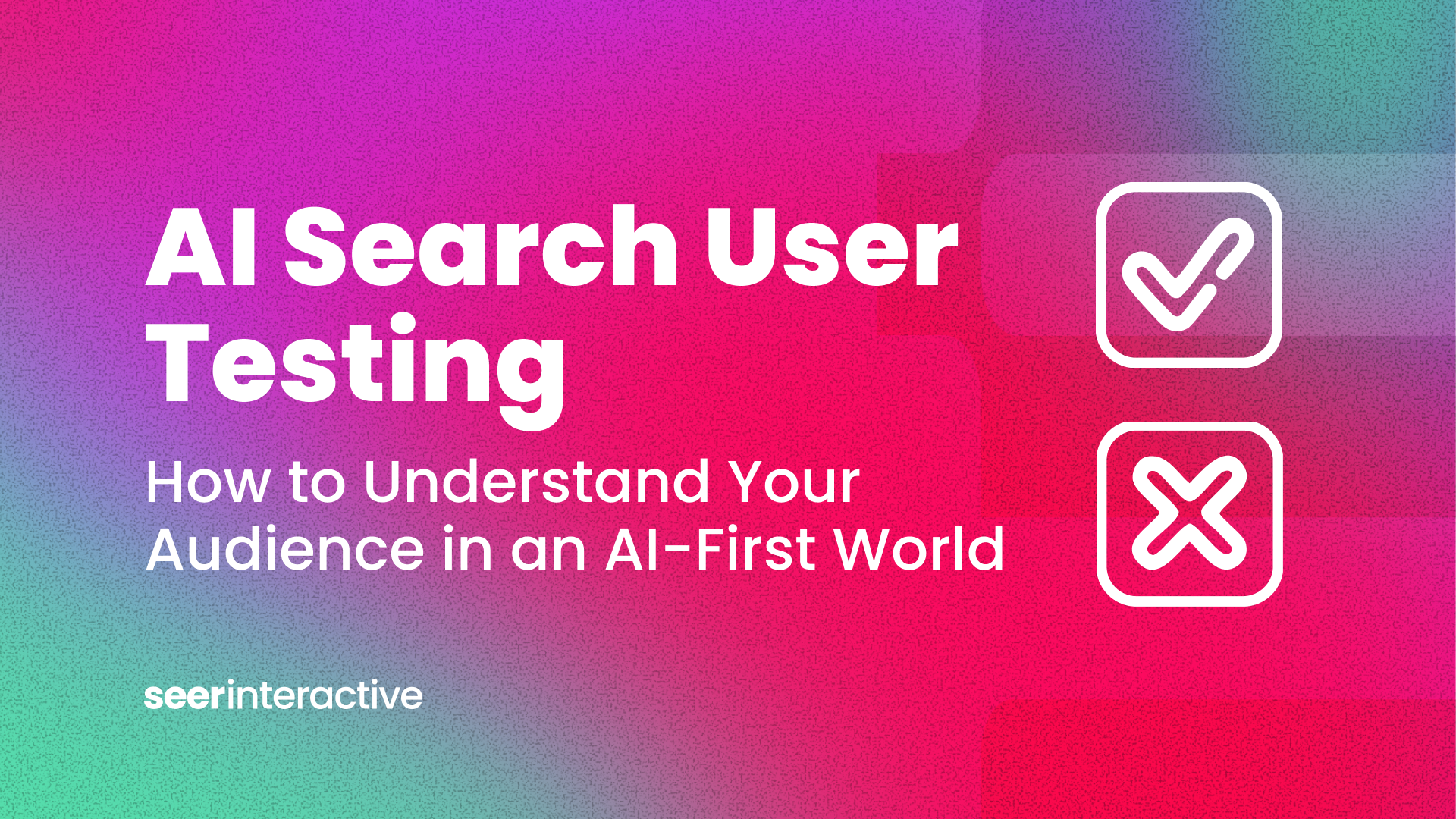At Seer, we have a culture that prioritizes innovation. There are benefits to that, which were obvious in the vast variety of SEO solutions we’d created for clients: Analyses, roadmaps, tactical and strategic deliverables. There are also consequences to that, as we don’t always have the time to pause and consider how new innovations fit in the overall offering. For better or worse, one byproduct of our culture is that we have dozens of different solutions to offer clients. Generally, that’s a good thing.
But for some clients, that volume of solutions created a problem.
Slowly, over time, on some accounts we found ourselves delivering upwards of a dozen disparate analyses as part of a single scope. Often those clients became overwhelmed with how everything fit together. The feedback we got was consistent: Seer’s work is great, the insights are powerful, and I am unsure what to do with it.
Enter the Expansion Roadmap.
This has been a labor of love for the past two years. With the help of many people in the SEO division, we’ve created a framework which contextualizes a wide variety of analysis to answer one question: How do we win the most market share in organic search?
The SEO Expansion Roadmap: What, Why, and How
A picture is worth a thousand words, so let’s start with some visuals.
The What
The first step to the Expansion Roadmap is identifying the full universe of keywords that can generate revenue or assist in revenue generation. The search volume for this full universe of keywords represents the Total Available Market (TAM).
We then categorize the TAM into tiers, starting with the keyword categories that are easiest to penetrate and moving towards the most difficult and competitive. You can think of this as the staircase we’re advising our clients to walk up towards. We lay out all of the steps, and from there our clients can make an educated decision about which level they want to target. As is our habit, we leverage PPC and Organic data together to identify the revenue potential at each tier.
The Why
Next, we identify the common attributes for the domains winning in each tier of the TAM. This is largely populated by those many disparate analyses I mentioned. Our deep dives in everything from featured snippets to backlinks come in handy here, as we can identify what the winning domains have done to achieve those attributes correlated with success.
These attributes are organized by themes and subthemes that should look familiar to most SEOs. While we tweak the inclusions based on the domain we’re supporting, here is an example of what this may look like:
- Site Architecture
- Crawling & Indexing
- Core Web Vitals Metrics
- Schema Markup / Structured Data
- Domain Strength
- Internal Linking
- Backlinks
- Anchor Text
- Branded Domains
- Content
- Video Content
- Interactive Assets
- Content Freshness
- Word Count
- Page Count
- Publishing Cadence
- Featured Snippets
- People Also Ask Questions
- Images
- Category Pages
- Product Pages
- User Trust Signals
- Authorship (Bylines, Bios)
- Editorial Guidelines
- User Experience & Design
- Analytics
- Tracking
- Reporting
- Analysis
- Technology
- Split Testing
- Heat Mapping & User Behavior Tracking
- Brand
- Branded Search Volume
- Branded Product Search Volume
- Branded Rich Snippet Ownership
- Social Media
- Brand Ambassadors
- eCommerce (if relevant)
- Site Structure
- Live Chat
- Purchase / Check Out Capabilities
- Reviews
- Filtering
- Product Imagery
- Local
- Local Listing Visibility
- Localized Organic Results
The How
Lastly, we evaluate the Client’s organizational strengths, weaknesses, and limitations. We use these observations, as well as the findings around the “what” and the “how” to prepare a long term roadmap. This expands beyond “Here’s what to do in Q1” and generally extends anywhere from 2-5 years out.
These findings can fuel some really fantastic a-ha moments. Some version of the following narrative has happened several times:
- An executive doesn’t understand why we can’t outrank a behemoth in their space (like NerdWallet).
- Our narrative pivots and instead of saying “we can’t outrank NerdWallet,” we outline “what it would take to outrank NerdWallet”.
- This outline includes:
- dozens of FT staff writers
- an overhaul of the tech stack
- investments in legal & compliance review
- a pivot away from all content being in the voice of the brand to individual authorship
- The executive now understands why they can’t outrank a behemoth in their space.
Expansion Roadmap findings that surprised us (and our clients) in 2023
One of the benefits of taking the time to organize our data and analyses into this framework is that we can debunk long-held assumptions. A core part of our vision at Seer is a rebuttal of best practices in favor of unique data.
We don’t want to deliver a standard checklist to our Clients and hope that it works for them. This inevitably leads to the client making bets that won’t pay off. We want to enable our clients to make the most strategic and calculated bets possible—and really support their charge to do more with less.
The whole point of this exercise is to identify what to invest in to win market share in a specific universe of keywords. We have seen some findings that rang true across all Expansion Roadmaps, as well as findings unique to a single Client’s TAM.
Here are a few findings that surprised us last year, and ultimately ended up saving our Clients some serious time and effort:
- How Important Are Core Web Vitals (CWV)? Not very, says some of our findings.
We’ve seen very little correlation between CWV scores and Page 1 rankings. And in fact, there has not been one instance where higher CWV scores = more keywords ranking on Page 1 across our clients’ competitive set. - More Pages = More Rankings? Not always.
If you know anything about SEO, it’s easy to assume that generally speaking more pages of content = more rankings. If a Client is concerned about volume (of rankings, traffic, or leads), then a fair guess is to propose they need more content. We have seen many examples where that’s not the case, and instead investing in E-E-A-T principles (authorship, fresh & in-depth content) on fewer pages has led to better results. - More Links = More Rankings? Yeah, sometimes.
I have seen a massive shift in the belief around the importance of links since I started doing SEO. In my early years, link building was 90% of what I did, and it worked very well. Over the years link building has gotten a bad reputation, deservedly so. But there is certainly a middle ground to consider, and when working with a relatively nascent domain, building (or attracting) links can be a high priority. - Improving internal link structure is (almost) always an opportunity.
In reviewing the past year’s Expansion Roadmaps, I noticed that internal links came up consistently as a near-term priority to invest in. - Structured Data is (almost) always a first-level priority.
For anyone who has been paying attention to SEO this year, this shouldn’t come as a surprise. For a variety of reasons, structured data is worth prioritizing as quickly as you can. We will continue to test and monitor this as Google continues to remove some of the rich snippets previously found in SERPs. - User Experience is an SEO priority.
This has been echoed in the materials released in Google’s Anti-Trust lawsuit. Many marketers think of User Experience and CRO as a different discipline. SEO drives the traffic and CRO converts it, right? Not so, in our findings. Strong user experience is positively correlated with strong visibility in organic search. - Video might need to be prioritized sooner than you think.
Many marketers, myself included, might see investing in video as the initiative they will get to eventually, once all the basics are complete. Well, in our findings we are seeing more examples of a strong video strategy being a necessary investment for a foundational content strategy.
I’m looking forward to seeing the Seer team complete more of these Expansion Roadmaps in 2024 and sharing the key findings with you all. If you’d like to continue the conversation on any of these findings, please find me on X or LinkedIn!
If you’re interested in Seer executing an Expansion Roadmap for your brand, please reach out here.


